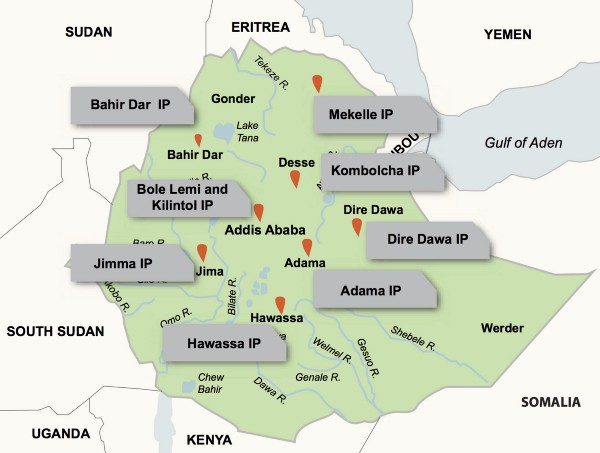Ethiopia has placed orders worth 10.5bn birr ($650m) for three industrial parks, each of which will be built by a different Chinese contractor.
Two of the parks will be in Ethiopia’s capital city, Addis Ababa, while the third will be in Jimma, about 200km to the south-west.
One of the capital’s parks, Bole Lemi II, will make garments. This $155m scheme will be constructed by CGCOC, a private Chinese contractor with a presence across Africa and a well-established business in Ethiopia. It will have an area of 186ha and is due to be completed in 12 months.
The other park in Addis Ababa is the 337ha Kilinto, which will make pharmaceuticals and medical equipment. This has been awarded to CTCE, a subsidiary of China Railway Engineering. The cost is estimated to be $240m, and the project length will also be 12 months.
The consultant for both parks will be South Korean firm DOHWA.

A map of parks that have been built or are under way (IPDC)
The Jimma scheme will be another garment centre, to be built by China Communications Construction Company at a cost of $66m. It will be completed in nine months.
Sisay Gemechu, chief executive of the Ethiopian Industrial Parks Development Corporation, told reporters that the work would be partly financed by a $158m loan from the World Bank.
This announcement follows the commissioning of four agro-industrial parks at the start of the year. These schemes will be financed by Ethiopia’s federal and state governments, and the Development Bank of Ethiopia has approved an initial $310m loan.
They are part of a plan to build at least 17 parks and thereby increase the contribution made by manufacturing to the Ethiopian economy, which up to now has been largely reliant on coffee and flowers for its export earnings.
According to Ethiopian government figures, agriculture accounted for 90% of the country’s foreign currency earnings and 85% of its employment in 2014/15.
The development of a light industrial sector has been made possible by the provision of power and transport infrastructure, through large-scale hydro schemes such as the Grand Renaissance Dam, which is due to be completed this year, and the Addis Ababa to Djibouti railway, completed this month.
Image: Ethiopia is using industrial parks to kick-start its manufacturing sector (Ethiopian Investment Commission)
Further reading:
Comments
Comments are closed.











well great for Ethiopia, but why is everything only in oromia or tigray? are Amharas still Ethiopian? are we still part of Ethiopia? nothing change! no development I can’t see the difference between woyanes or tigray or ohedid or oromos! both government have hate for the Amharas and they went keep Amharas economically, and in every way out of it!